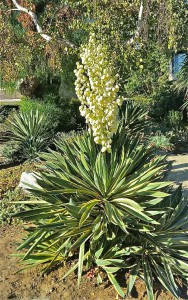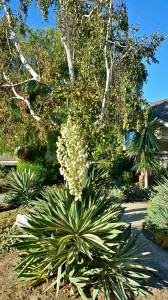The agave species is native to the Southwest and does well in our climate, especially once established (first year usually). Considering the drought reports and arid area we live in, it would be wise to consider replacing any plants that are not flourishing with native, Mediterranean and/or succulent varieties. Moving towards a low-water garden does not doom you to a boring landscape. Au contraire, mon amie. Cacti, succulents, California hardy types, ornamental grasses, yuccas and herbs from exotic locations can still bring in colors, variegations and possibly even more drama and texture than you ever expected from an environmentally and socially conscious tableau. Water-wise or dry gardening can become a wonderland of interest with stepping stones, pebbles of different colors and sizes (from gravel to blue grey river stone), water features such as bird baths, fountains and streams as well as interspersed with statues, boulders and a myriad of garden art.
On our walks we comment and discuss the seasons, the scenery and nature as it changes. J took this picture of a flowering Mexican agave bracteosa in someone’s established front yard. Flowers can take up to 10 years to appear and can signal the end of life for an agave but undoubtedly young off shoots are gathered all around the Mother plant and are ready to transplant or remain in place.


